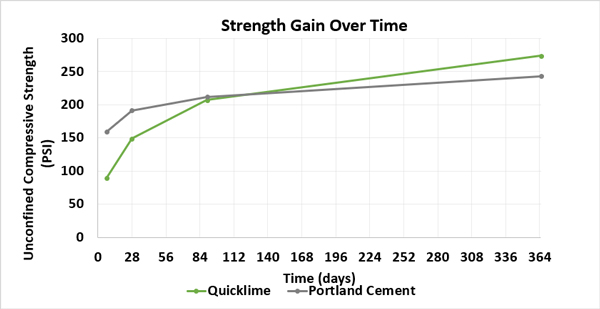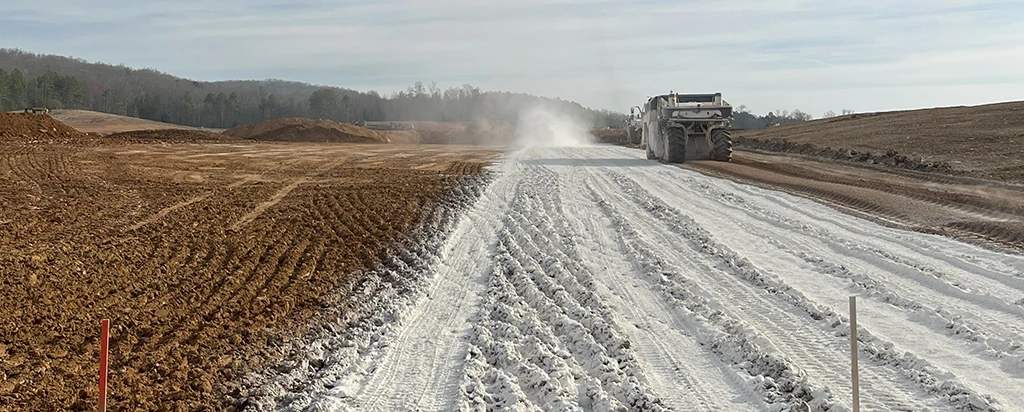Solutions
Soil Stabilization
What is Soil Stabilization?
Soil stabilization is a process by which the properties of a soil are transformed to provide permanent strength gains and enhanced engineering properties, especially with fine-grained soils. Additional benefits of soil stabilization include increased durability, lower moisture absorption, reduced shrink/swell potential, resistance to freeze/thaw cycles and the potential for reduced pavement thickness, particularly in flexible (asphalt) pavement design.
Techniques of Soil Stabilization
Lime stabilization is one of the best soil stabilization techniques, which uses lime-based reagents, such as quicklime, CQL, hydrated lime or Calciment® LKD (lime kiln dust), to develop strength. According to a 2017 study conducted by Louisiana State University titled Lime Utilization in the Laboratory, Field, and Design of Pavement Layers, lime stabilized subgrades over perform non-stabilized subgrades when construction, materials and durability design are properly considered. This study reviewed best practices, test methods, field applications and construction techniques surrounding the usage of lime and concluded that lime is not liable to leaching and remains in the soil for years. Additionally, in pavement design, a structural layer coefficient of 0.11 should be associated with lime-stabilized subgrades.
Benefits of Soil Stabilization
Improved geotechnical properties
Soil stabilization can improve in situ, or natural state, soils eliminating the need for expensive remove-and-replace operations. Often roads, building pads, parking lots, runways or other structures need to be built on naturally wet, weak soils. Those soils can be treated through soil stabilization to add strength and improve their engineering properties. Pre-project laboratory testing is essential to be certain that the right product is used for each project and that enough of the stabilizing agent is present to permanently stabilize the soil.
Short and long-term strength gains
The pozzolanic reactions that take place when using a lime-based reagent will dramatically increase the strength and load-bearing capacity of your subgrade.

Reduced plasticity to minimize shrink / swell potential
In addition to adding strength, stabilized soil forms a solid monolith that decreases permeability, which in turn reduces the shrink/swell potential and the harmful effects of freeze/thaw cycles. The shrink/swell potential of a soil is the amount that a soil can change in volume depending on the moisture content – some expansive soils can expand as much as ten percent! This drastic change in volume can easily produce enough force to cause serious damage to a home or other buildings, roadways, or runways. When moisture penetrates soil, expansion associated with freeze/thaw cycles can easily ruin compaction and harm any structure that is built upon it. The virtually impervious lime-stabilized soil minimizes the possibility of losing compaction.
How does Soil Stabilization Work?
Lime stabilization uses calcium, pozzolans and water to generate cementitious bonds that permanently strengthen a soil, improving its engineering properties. Lime increases the pH of a soil to the point that naturally present pozzolans (silica and alumina) are solubilized, making them available to form strong bonds, calcium-silicate-hydrates (CSH) and calcium-aluminate-hydrates (CAH). These naturally occurring pozzolans are present in soils containing clay. In general, the more clay that is present, the more pozzolans that are available to react. However, lab testing is important to determine just how reactive a soil is.
Depending on the project and application, calcium is supplied by either quicklime, CQL, Calciment® LKD or hydrated lime. Silica and alumina react with the calcium and water to produce the previously mentioned CSH and CAH. These products are the same creations that are responsible for the strength in materials such as concrete; they form long-term, permanent bonds that drastically improve the bearing capacity of a soil and keep improving over time. As long as there is calcium, pozzolans and water present, lime stabilized soil can continue to gain strength for a very long period of time, even over a year. Learn more about the importance of soil stabilization.
What is the Soil Stabilization Process?
The soil stabilization process begins in the laboratory where soil samples are analyzed to determine how much lime is necessary to permanently stabilize the soil. The Eades and Grim pH test (ASTM D 6276) is a relatively simple test used to determine the amount of lime needed to properly break down and stabilize soil.
After the application rate is determined, soil stabilization at the construction site can commence. First, material is delivered to the site, usually in pneumatic tankers, but depending on jobsite needs, dump trucks and bulk bags can also be used. The material is then spread throughout the site at the predetermined rate, either by spreader trucks or mechanically by excavators. Industrial reclaimers then thoroughly mix the lime with the soil, and water when necessary, so the stabilizing reactions can commence. These reactions produce long-term permanent strength gains. After the soil is thoroughly mixed, compactive efforts and grading can take place before a final smooth roll makes the stabilized soil ready for further construction to take place. To learn more about soil stabilization methods & materials, check out our blog.
Soil Stabilization Products
Quicklime
Quicklime is used in soil stabilization applications to develop long-term permanent strength in fine-grained soils, high in silt and clay content. Quicklime can come in two types, high calcium and dolomitic. High calcium is almost completely calcium oxide (CaO), whereas dolomitic quicklime contains a portion of magnesium oxide (MgO) along with calcium oxide. While some industrial applications, such as steel, need the magnesium component for certain processes, for construction purposes high calcium and dolomitic are virtually indistinguishable.
Construction Quicklime (CQL)
Construction Quicklime (CQL) is used for soil stabilization in the same applications as quicklime to strengthen fine-grained soils that are high in clay content. CQL offers a few additional benefits for stabilization including a reduced mellow period and accelerated early strength. Offering a reduced mellow period of only four hours allows contractors to expedite project timelines, reducing downtime and increasing productivity. CQL also promotes earlier strength development, which helps establish a working platform faster than traditional quicklime.
Calciment® LKD
Calciment® LKD, is a co-product of the quicklime manufacturing process that contains a combination of CaO, MgO and pozzolans. Because it contains both lime and pozzolans, Calciment® LKD is somewhat of a hybrid between quicklime and cement. As previously mentioned, lime works very well with fine grained soils and especially thrives as the clay content and plasticity increase.
Hydrated Lime
Hydrated lime, also known as calcium hydroxide (Ca(OH)2) hydrate or slaked lime, is quicklime that has been further processed. It has been carefully combined with the proper amount of water and agitation to produce a very fine, high-purity product. Hydrated lime can still supply the calcium that is essential to stabilize certain soils by forming cementitious bonds. However, it is only available in certain areas, there are additional costs for the added processing and its availability is seasonal.
Related Blog Posts
More on Soil Stabilization
Ground Control: Comparing Lime and Geosynthetics for Long-Lasting Stability
When building infrastructure on weak in-situ soils, a well-designed foundation is essential to ensure long-term resilience. Whether you're constructing roads, embankments, or industrial platforms, ensuring subgrade stability is critical—not just for performance, but...
Save Time and Money with Mintek’s Lime Stabilization Calculator
Lime stabilization turns challenging soils into durable foundations suitable for the construction industry. When lime-based reagents interact with soil, a chemical process alters its characteristics - binding clay particles, reducing plasticity & shrink-swell...
Exploring The Application of Lime Stabilization in Soil
Creating a stable foundation is essential for any construction project, yet many construction sites face challenges with unsuitable soil conditions. Lime soil stabilization offers a proven, cost-effective solution for transforming problematic soils into reliable...


